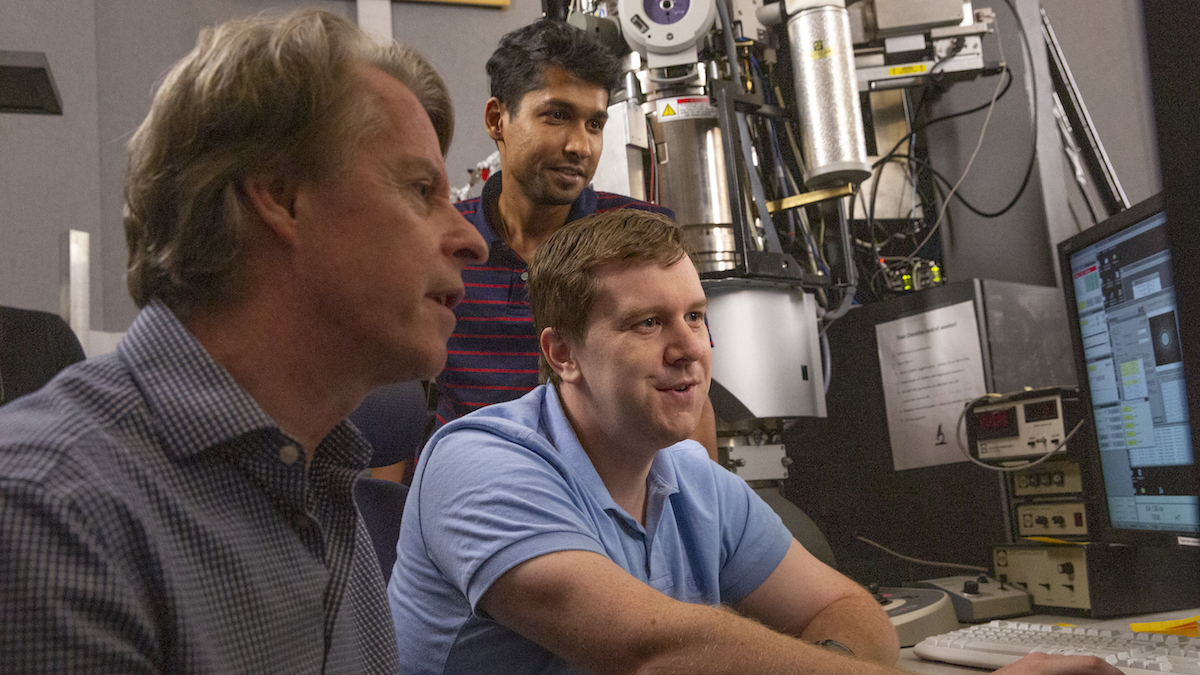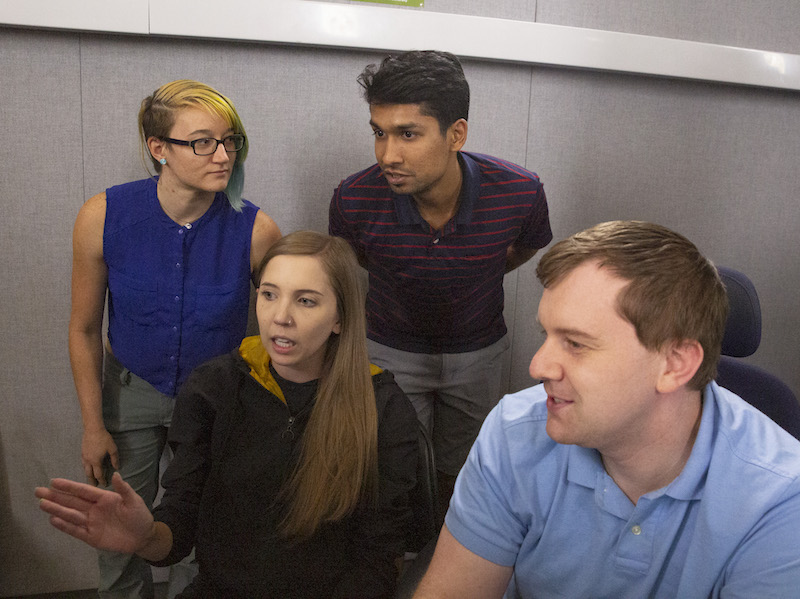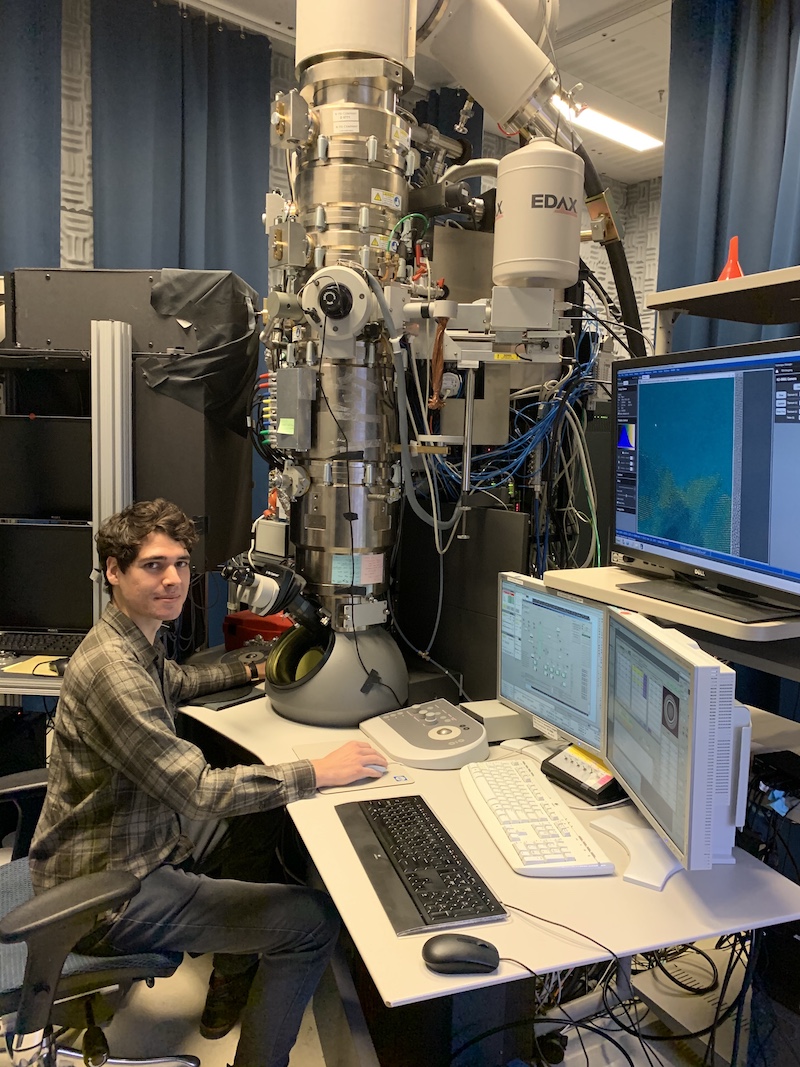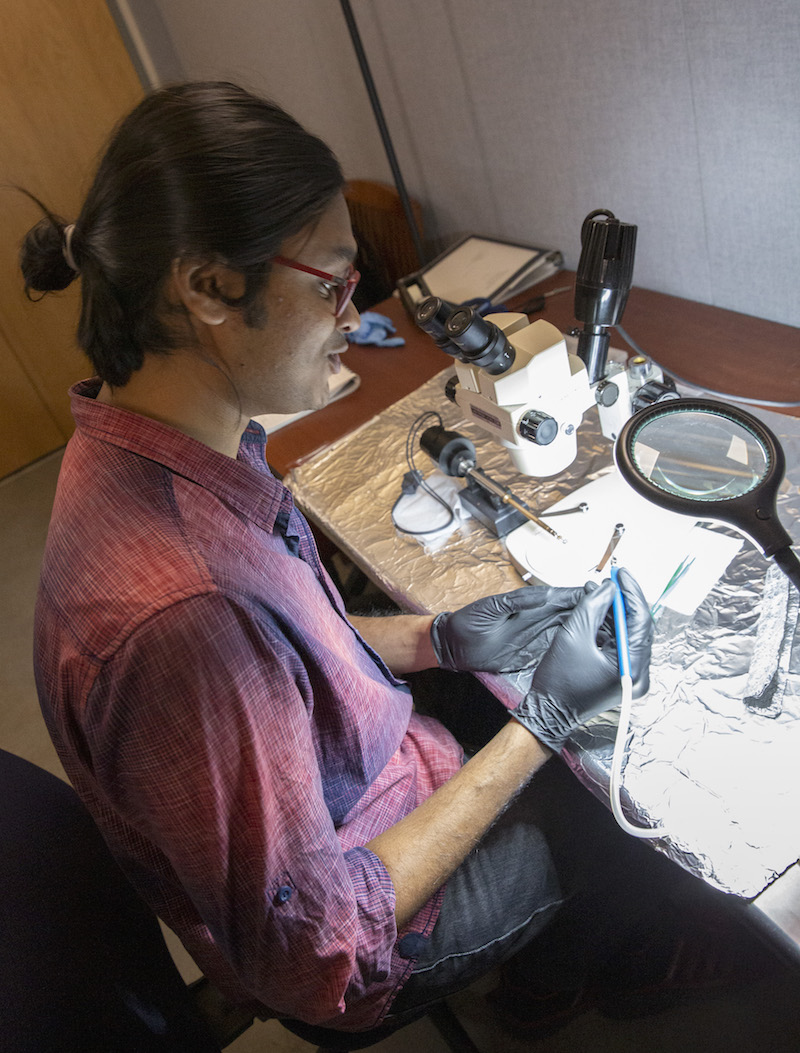
Dancing atoms reveal potential capabilities of materials
Energy generation, environmental science, electronics, manufacturing and more would benefit from exploring materials’ innermost architecture

Above: Professor Peter Crozier (at left) applies his expertise in electron microscopy in research to improve materials used to expand and enhance the capabilities of numerous advanced technologies, especially those employed in energy and environmental fields. Crozier is pictured with postdoctoral research fellow Barnaby Levin (sitting) and doctoral student Kartik Venkatraman in the Southwest Center for Aberration Corrected Electron Microscopy on Arizona State University's Tempe campus. Photographer: Connor McKee/ASU
An important part of Peter Crozier’s job involves watching dances. He views these intricate performances through state-of-the-art, high-powered microscopes because the dancers are atoms.
Crozier is a materials scientist at Arizona State University who studies how the underlying principles of nature can be applied to pursuits in materials science and engineering.
To do that, he examines the choreographed ways in which materials form at the atomic level and how those materials develop various functionalities.
“Think of graphite and diamonds, two very different materials. Diamonds are hard and transparent. Graphite is soft and black. Yet they are both pure carbon,” says Crozier, a professor in ASU’s Ira A. Fulton Schools of Engineering.
“The only difference between diamonds and graphite is the way their atoms are arranged in their most basic structures, how they are stacked together in those crystalline patterns,” he says.
Deeper understanding of the ways atoms assemble and bond in materials promises to provide insights into a vast array of chemical and biological systems, energy engineering, environmental sciences and even the complex realm of emerging quantum information technologies.
Progress toward that goal has earned Crozier and his colleagues a National Science Foundation Major Research Instrumentation award. It provides more than $1.8 million to fund the acquisition of a direct electron detector, a technology that will boost the team’s work in advanced transmission electron microscopy.
The new equipment — described by the NSF as an Energy-Filtering, Direct Electron Detector for Advanced Soft and Hard Materials Research — will give researchers a sharper view of “atomic positions and dynamics,” Crozier says. Or, in other words, it will allow him to see the so-called dances of the atoms.
Learning new ways to use catalytic materials
The detector will enable researchers to examine advanced real-time, atomic-level identification and characterization of the structures of soft and hard materials in situ, or in their natural working environments.
In situ studies also allow a closer look at how materials at the atomic level perform as catalysts, or substances that can trigger and speed up chemical reactions.
This is important because catalytic materials are used to manufacture about 80% of the world’s industrial products, including pharmaceuticals, agricultural materials and most other chemical-based commercial products, Crozier says.
These processes are at the core of the investigations of the Crozier Research Group @ ASU, which focuses on microscopy to help reveal how catalysts can be used to develop more sustainable, renewable clean-energy technologies.
The research is also essential to re-engineering conventional energy sources such as fossil fuels to work more efficiently and to significantly mitigate their harmful environmental impacts.
Accomplishments are attracting support for myriad projects

Professor Peter Crozier credits efforts of his student lab assistants for helping him achieve important steps in advancing materials science and engineering research. Pictured in Crozier’s lab space are (left to right) doctoral students Tara Boland, Diane Haiber, Kartik Venkatraman and post-doctoral research fellow Barnaby Levin. Photographer: Connor McKee/ASU
Crozier’s team of graduate students and postdoctoral researchers performs most of its work at the Southwest Center for Aberration Corrected Electron Microscopy on ASU’s Tempe campus. The team is starting to see the payoff for the important steps in materials science that the facility has enabled the group to make in recent years.
In addition to the funding for the direct electron detector, in recent months Crozier has also won the NSF’s support for two other research endeavors.
For one project, Crozier is the lead investigator for a team of researchers at six universities that will use advanced machine learning to study the atomic level structural dynamics of catalysts.
The other project is aiming for more extensive understanding of electroceramics, a class of materials with strong electrical properties that are proving to be valuable in technologies for energy conversion and storage, electronics and catalysis.
Earlier this year, Crozier also earned funding from the U.S. Department of Energy to study the use of photocatalytic materials to make solar energy-based fuels. That involves developing materials to perform photocatalysis to split water into hydrogen and oxygen. The hydrogen will be the fuel.
The new direct electron detector will benefit each of those additional projects.
Expanding the boundaries of electron microscopy’s possibilities
With the detector, Crozier’s team will get images recorded up to a thousand times per second to show how atoms rearrange during catalytic reactions, allowing for the precise measurements of the chemical identities and the bonding of the atoms.
“We are going to be able to more closely probe a material to see how the atoms on nanoparticles change bonding and position,” Crozier says.
He hopes to also see the research produce ideas for enhancing the abilities of microscopy technology.
“We do more than simply use our microscopy tools,” he says. “We develop new hardware and software for them and come up with new ways of using them.”

Chemical engineering graduate student Joshua Vincent, one of Professor Peter Crozier’s research assistants, is shown operating a transmission electron microscope at the National Institute of Standards and Technology. It’s the same type of microscope Crozier and his lab team use to study the movements of atoms in the presence of different stimuli such as heat, gas and light. This “dance” performed by atoms depends on the types of stimuli. Photo courtesy of Joshua Vincent.
Colleagues in Crozier’s field are anticipating interesting and useful results from his current projects.
“I am constantly impressed by Peter’s ability to squeeze valuable information out of the microscope that is essential for designing new catalysts and improving the performance of existing ones,” says Frances Ross, a professor of materials science and engineering at the Massachusetts Institute of Technology, who uses transmission electron microscopy to gain knowledge about the physics and growth mechanisms of nanoscale materials.
Ross says Crozier’s work to develop specialized microscopy equipment is having a significant impact on the research community by expanding the possibilities of what the technology could do, which is encouraging others to attempt more complex experimentation.
Jingyue Liu, a professor in the Department of Physics at ASU, foresees Crozier’s research answering fundamental questions about the development of low-cost and sustainable catalysts for energy conversion, environmental remediation methods, preventing corrosion of materials, improving detection of toxic chemicals and upgrading water-cleaning systems.
Projects are also bolstering student opportunities and public outreach
Additional benefits of the research are coming from the efforts of students beyond their labors in the lab, says Crozier, who is chair of the graduate program for the School for Engineering of Matter, Transport and Energy, one of the six Fulton Schools.
He encourages his student research assistants to broaden their impacts by engaging in activities that provide opportunities for them to develop their managerial and leadership skills.
Many of the group of about a dozen doctoral and undergraduate students are involved in science and engineering organizations, community service projects and educational outreach.
Some have taken leadership roles in the Microscopy Society of America. Recent graduates Will Bowman and Ethan Lawrence were part of a group of six students who established a student council within the national organization. They also chaired a pre-meeting congress at one of the society’s national meetings.

Materials science and engineering doctoral student Piyush Haluai prepares a nanoparticle catalyst sample to insert into an electron microscope. Haluai is aiding Professor Peter Crozier’s work on the use of nanoparticles in photocatalytic processes to generate solar fuel. Photographer: Connor McKee/ASU
Lawrence is now an engineer with Intel, while Bowman is now an assistant professor of materials science and engineering, professor at the University of California, Irvine.
Current students Kartik Venkatraman, Joshua Vincent and Piyush Haluai are involved in organizing student and professional activities in the Microscopy Society of America.
Crozier has created a Leadership Circle for materials science and engineering graduate students at ASU aimed at getting them involved in management and leadership of the graduate program.
As part of these efforts, doctoral student Diane Haiber has developed and organized two seminar series to provide other graduate students opportunities to connect with academic, research and industry leaders in the microscopy and materials science and engineering fields.
In the announcement of Crozier’s Major Research Instrumentation grant, the NSF noted the “strong commitment” of Crozier and his team to participate in outreach at and beyond ASU. Those efforts include educational programs targeted to rural and underprivileged K-12 communities through the Fulton Schools and ASU’s College of Liberal Arts and Sciences and an annual Electron Microscopy Winter School at ASU, which draws graduate students from across the U.S. and the globe.
Soon a new generation of researchers will understand atoms’ most intricate dances.



































